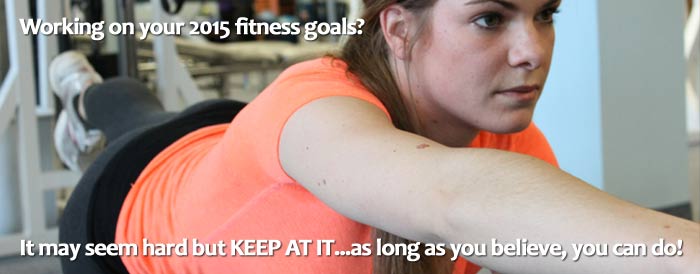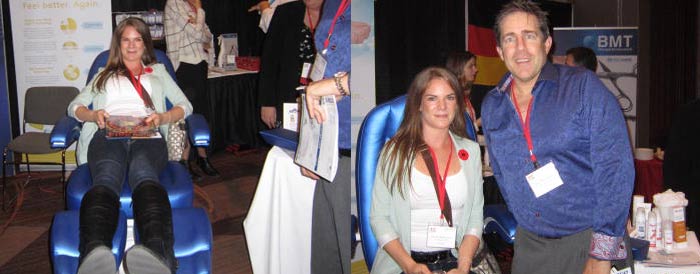Safer Way to Travel During The Winter
In the cold winter months when we are experiencing the deep freezes, be on the look out for slippery surfaces. Falls due to slippery conditions can lead to unnecessary injury. Significantly reduce the risk of slipping by wearing the proper foot gear and using a pair of Ice Traxx. These easy on and off boot grips help improve traction with sneakers, boots, dress shoes etc. The ground gripping steel studs make this accessory a great option for winter safety.
These boot accessories are very affordable. You can purchase a pair of Ice TRAXX at our clinic for $10. See reception for details.
Achieving Fitness Goals
Ten things to consider as you work on fitness goals for the new year:
- Create realistic and specific goals.
Aim high but be realistic. Setting a goal of running a marathon(42K) within the next year when you’ve never even run a 5K distance may be a situation where your intention may be genuine but the practicality may be unreasonable. If you don’t run regularly, start with a goal of committing to 1 – 2 runs per week with a goal of 4 – 5 times per week within 6 mos. Make your goals meaningful but practical and remember small steps are all that is required…no need to hit a home run every time. Running for 20-30 minutes 3 times a week is better and safer than a 60 minute run once every 1 – 2 weeks.
Also, be specific. Start with “I’ll exercise 3 mornings a week” versus, “I’ll start going to the gym more this year”. - Choose fitness activities that you enjoy.
Fun and enjoyment are terrific motivators. Select fitness activities that challenge you, but that you can enjoy. Fitness activities work better when there’s a personal fit – exercises or classes that YOU enjoy which also make you feel good about you and your ability to achieve your goals. If you can do it for enjoyment instead of out of obligation, you will have found the magic mixture. Whether alone, in a highly active group like a Zumba or Spin class, make it your plan to find an activity that you enjoy. - Don’t set goals for the year…create monthly targets instead.
Remember to set realistic, simple goals. Avoid long term goals that may seem unattainable chores. Instead set new goals monthly. These are easier to measure and will thus keep you motivated. As you achieve a short term goal, you may push yourself for a bigger challenge. This approach helps you to be flexible. Some weeks you may fall short, then the next time you may surprise yourself. Your fitness is for you and you want to succeed so set goals that you can touch and feel so you see your accomplishments. - Accountability needs to be part of the process.
What’s your accountability plan? What ensures that you are on track? As mere mortals accountability is vital. You may set your own accountability schedule by writing down and checking off planned activities. Alternately, have a helper or find a buddy and work at keeping each other accountable. A Trainer, if affordable, is a great asset and incentive for motivation and accountability. Whatever method you use make it a regular and fairly rigid process. - Success comes easier in twos.
Exercising with another person increases fitness success rates. A gym or fitness buddy adds motivation, accountability, regularity, and best of all fun! Plan your workout, gym or exercise classes early to attend together. If you can’t find a friend, make one at a gym or exercise class. - Recognize the small accomplishments along with the big ones…and reward yourself!
As you set and achieve those small goals reward yourself!! Celebrate successes alone or with others, and let the world know you have lost two inches – if that was your goal. Treat yourself to something that you enjoy. Perhaps purchase that two sizes smaller outfit that you were eying; or splurge on a favourite meal or movie with your buddy or a friend. You have done well!! - Keep a record of your progress.
As you complete your daily exercise activity write it down. Not only is it a useful way to track progress, it’s something that you can refer to for encouragement if you get of track. Seeing how much you’ve completed often provides that incentive to continue. - The reason for doing should be for more than just weight loss.
There is much more to getting active than just to lose weight. It’s the fuel for becoming a healthier, stronger, feeling better about yourself and ultimately happier individual. The way you look will is just the icing on the cake (the cake reference is figurative…not a fitness recommendation). - As each new day comes, act like it’s the first day of the year.
The new year provides great motivation for introducing new habits and goals into our lives. But once the first few days pass, falling back into a rut can be a danger. Create new motivation for yourself by treating each day as the start of the year…look at it as an opportunity begin a new and before you know it you’ll have formed a habit that makes it easier to continue. - If you fail by stopping, simply start again…stumbling blocks are part of the process!
Do not be discouraged. Resolutions are not always easy to stick to. Stumbling or stopping is okay as long as you get back up and start again. Once you falter, assess the reason and resolve to start again. If building momentum is hard, reevaluate your approach. Perhaps try a different method, set a smaller goal, or give yourself a short break. Don’t give up! Resolve to starting again and again until you find your rhythm towards success.This is your life, and you only have one so take good care of it. Think positive. Have FUN and remember, if you truly believe you can, you will!
YRA attends Annual Chiropody Conference in Niagara Falls
Managing partner Glenn Woodland along two staff (Sue and Taylor) attended Chiropody Conference in Niagara Falls Nov. 7 – 8, 2014. Delegates came from across canada. Event consisted of workshops and product displays showcasing the latest in foot product technology.
Picture above includes Taylor and Glenn who are testing out the newest technology in chiropody seating for patient care and comfort.
Course Completed: The Shoulder – Theory and Practice
Jen and Ann attended this evidence-based theoretical and practical course which is based on extensive clinical experience in assessment, diagnosis and rehabilitation of shoulder pathology, as well as extensive reference to research publications from a variety of disciplines. Models of shoulder assessment including the Shoulder Symptom Modification Procedure (Lewis JS (2009) British Journal of Sports Medicine) and a new model for staging the continuum of rotator cuff tendinopathy (Lewis JS (2010) British Journal of Sports Medicine) were presented. Emphasis was placed on clinical reasoning to support management decisions. Participants completing these courses gained a greater understanding of the anatomy, biomechanics, assessment and evidence-based treatment of this interesting and complicated region of the body.
Certification in Neuro-Developmental Treatment
Samantha is now certified in the NDT (Neuro-Developmental Treatment) approach which extends beyond receiving training in this hands-on, problem solving approach to treating clients with neurological challenges.
NDT Certified Therapists receive intensive post graduate training which includes successful completion of an NDTA Approved certificate course, and are held to meeting specific continuing education standards set by the NDTA organization. This continuing education process insures that the therapist is using current NDT theory, methods and techniques into their practice when treating a client.
The therapist’s education in neurology, physiology and current research (I.e. new models, theories, information in movement sciences, motor learning) is translated into daily practice to progress the client through a process of ongoing assessment to achieve positive functional outcomes quickly and efficiently. This comprehensive NDT approach utilizes specialized clinical training to assess and identify a client’s strengths and impairments and treat them in relation to their functional abilities and limitations.
For more information on the NDT approach please refer to the NDTA website at www.ndta.org.




